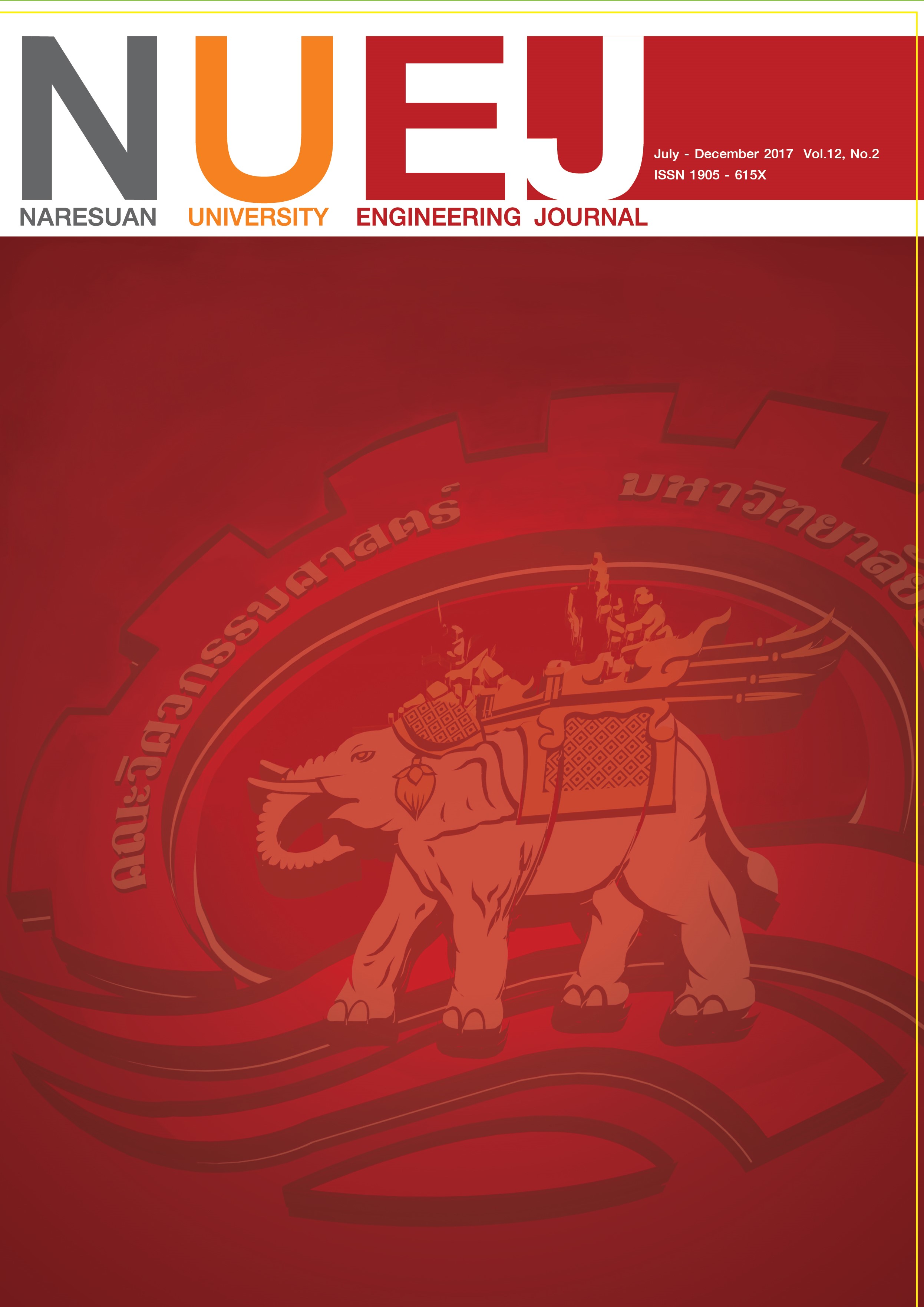การเพิ่มสัดส่วนก๊าซมีเทนที่แหล่งกำเนิดของน้ำเสียโรงงานน้ำมันปาล์มโดยวิธีการหมุนเวียนน้ำเสียผ่านคอลัมน์คายก๊าซ In-situ Methane Enrichment of Palm Oil Mill Wastewater by Effluent Recirculation to Stripping Column
Main Article Content
Abstract
Biogas utilization often experiences a relative low calorific value due to high carbon dioxide (CO2) content, a CO2 product from anaerobic digestion process, resulting in a low of methane (CH4) : CO2 ratio. The objective of research is to study the effects of the recirculation rate of wastewater from biogas fermenter tank to discharge gas tank. The goal is to reduce the CO2 in the biogas produced from palm oil mill wastewater using anaerobic fermentation process, which would increase the proportion of methane in the biogas produced. The recirculation rates were studied at the rate of 0%, 230%, 330%, and 430% of the total volume of digester volume through the stripping tank size of 11 liters, which is installed with Chiang Mai University channel digester (CMU-CD) acted as an anaerobic digester size 1100 liters. The results showed that the recirculation rate at 230% of the total volume of digester volume was optimum rate for the increase of CH4 in the biogas plant. This rate produce about 71.0±6.2% of CH4 and remove about 111±17 milliters of CO2 per liters of air with the loss at 5.9% of CH4. It is therefore one alternative to enrich the concentration of methane in biogas from the palm oil wastewater.
Article Details
References
กรมพัฒนาพลังงานทดแทนและอนุรักษ์พลังงาน. (2558). แผนพัฒนาพลังงานทดแทนและพลังงานทางเลือก พ.ศ.2558-2579. กรุงเทพฯ: กระทรวงพลังงาน
กรมพัฒนาพลังงานทดแทนและอนุรักษ์พลังงาน. ศักยภาพการผลิตและการนำก๊าซชีวภาพไปใช้เป็นพลังงาน. [เว็บบล็อก].สืบค้นจาก http://biogas.dede.go.th/biogas/web_biogas
มหาวิทยาลัยเชียงใหม่ สถาบันวิจัยและพัฒนาพลังงานนครพิงค์. (2558). โครงการปรับปรุงคุณภาพก๊าซชีวภาพที่แหล่งกำเนิด. เชียงใหม่. มหาวิทยาลัยเชียงใหม่.
จุฑามาศ บุบผาพวง. (2558). การเพิ่มความเข้มข้นของไบโอมีเทนที่แหล่งกำเนิดโดยการหมุนเวียนน้ำทิ้งจากคอลัมน์ถังคาย. (วิทยานิพนธ์ปริญญามหาบัณฑิต, มหาวิทยาลัยเชียงใหม่).
ปกรณ์ ถนอมพงษ์ชาติ. (2552). การแยกคาร์บอนไดออกไซด์จากก๊าซชีวภาพโดยการดูดซับด้วยของเหลวในคอลัมน์อัดตัว. (วิทยานิพนธ์ปริญญามหาบัณฑิต, มหาวิทยาลัยเชียงใหม่).
] มหาวิทยาลัยเชียงใหม่ สถาบันวิจัยและพัฒนาพลังงานนครพิงค์. เทคโนโลยีก๊าซชีวภาพ.[เว็บบล็อก]. สืบค้นจากhttp://www.erdi.cmu.ac.th/index.php/services/view?pid=1
วิศวกรรมสิ่งแวดล้อม. Parameter ต่างๆของน้ำเสียและความหมาย. [เว็บบล็อก].สืบค้นจาก http://enverionment.blogspot.com/
Ake Nordberg, Mats Edstrom, Marketta Uusi-Penttila, Ake C. Rasmuson. (2012). Selective desorption of carbon dioxide from sewage sludge for in-situ methane enrichment: Enrichment experiments in pilot scale, biomass and bioenergy, vol. 37, pp. 196-204.
Anna Lindberg, Ake C. Rasmuson. (2006). Selective Desorption of Carbon Dioxide From Sewage Sludge for In Situ Methane Enrichment—Part I: Pilot-Plant Experiments, Wiley InterScience.
O'Keefe, D. M., Brigmon, R. L., and Chynoweth,D. P. (2000). Influence of Methane Enrichment by Aeration of Recirculated Supernatant on Microbial Activities During Anaerobic Digestion, Vol. 71, pp. 217-224.
Richards, B. K., Herndon, H. G., Jewell, W.J., Cummings, R. J., and White, T.E. (1994). In Situ Methane Enrichment in Methanogenic Energy Crop Digesters, Biomass and Bioenergy, Vol. 6, pp. 275-282.
Supreeya Boontawee, Sirichai Koonaphapdeelert. (2015). In-situ Biomethane Enrichment by Recirculation of Biogas Channel Digester Effluent Using Gas Stripping Column, Energy Procedia, vol. 89, pp. 78-84.
APHA-AWWA-WPCF. (1992). Standard Methods for the Examination of Water and Wastewater. Washington D.C. USA. : American Public Health Association


